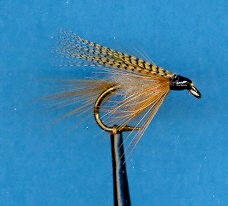
On The Fly
"Fly tying is a school from which we never graduate"
TYING NEWSThe Southern Oregon Fly Tiers met Thursday, September 22nd at the library in Gold Hill. There was a fly raffle and fly exchange along with demos. The membership voted to change the meeting date to the second Wednesday of each month. This will make it easier to get the key and also eliminate the holiday conflict in November and December. So join us the second Wednesday of each month for more fun and the sharing of the art.
 PATTERN OF THE MONTH - Dark Cahill Wet Fly
PATTERN OF THE MONTH - Dark Cahill Wet Fly
Hook: Wet fly, size 10 to 14
Thread: Black, 6-0.
Tail: Dark ginger hackle-barbs or Woodduck flank feathers.
Body: Dark gray muskrat fur or similar.
Hackle: Dark ginger
Wing: Woodduck flank.
Tying Instructions:
Step 1: Start the thread at a position on the hook shank that allows the proper room for the head. Use
this as a marker and donít tie anything past this mark. Wrap a thread base back to a position just above
the hook barb.
Step 2: Tie in a small bunch of ginger or flank barbs, one shank length.
Step 3: Form a dubbing loop, apply the dubbing, twist, and wind forward leaving enough space for the shaped
head.
Step 4: Tie in some dark ginger hackle barbs, throat style or wind the ginger hackle a couple turns, tie off,
divide on top, then hold them down on each side while winding back to form the beard.
Step 5: Select a well-marked flank feather and pull off the fuzz and fibers at the butt end, leaving a
feather equal to 1Ĺ times the finished wing length. Bunch the fibers between your fingers and hold them
flat over the body with the tip ends reaching the bend of the hook or a little past. Make sure the fibers
drape down on each side of the shank.
Step 6: Fasten the wing into position on the shank using a soft loop technique. Reposition if necessary,
take 3 tight wraps while holding firmly in place. Trim the butts.
Step 7: Form a small head, whip finish and cement.
Until the 1900's fly fishing in the US was done with wet flies originating in England. Some early wet flies were specifically tied to imitate insects, although itís not clear if it was an emerging nymph or a drowned adult that the tiers had in mind. Other flies are American originals tied strictly as attractors. But as fishing pressure increased the trout became more selective and the anglers more educated. The popularity of the wet fly diminished and has largely been replace by a huge variety of accurate imitations representing actual stages of subsurface life. Yet, because wet flies are attractive, fun to tie, easy to fish, and since trout will still hammer a Silver Doctor fished down and across stream, wet fly angling still has its fans.
Those who have studied the behavior of stream insects have found that several mayfly species leave their nymphal stage sooner in the life cycle than other species. The dun emerges while the nymph is still on the bottom or on its way to the surface. When this occurs, wet flies are extremely effective. However, many wet flies represent other insects as well. For instance, caddis pupae and diving caddis adults depositing eggs are imitated by wet patterns.
In the summer and fall months when the water is clear and low, a sparsely dressed Dark Cahill wet fly can prove deadly, especially cast tight against the overhanging bank. A wet Light Cahill version has always been a good imitation of the emerging stage of a variety of light colored insects.
TYING TIPS - Flank-feather Wing
Some tiers have trouble setting the wing in a low profile. The trouble is that they
place the wing on top of the shank where the front of the body will prevent the wing from laying flat.
Consequently, it sits halfway up in the air and interferes with the flyís performance. If you remember to
taper the body a little in front and let the wing fibers drape down a little on each side when tying them
in, the problem is solved..
Tie One On,
Dan Kellogg
(you can contact me at FLYGUY@EZNORTHWEST.COM)